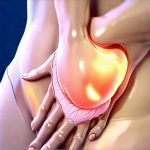Chronic pain conditions often disrupt sleep, leading to a frustrating cycle where pain intensifies at night – these are known as “night flare-ups.” Many individuals find themselves awake for hours, battling discomfort that seems significantly worse in the darkness than during the day. This phenomenon isn’t simply about increased sensitivity while resting; it’s a complex interplay of physiological changes that occur during sleep and rest. Factors such as reduced cortisol levels (our natural anti-inflammatory), altered pain processing in the brain, and decreased distraction from daily activities all contribute to this nighttime increase in perceived pain. Understanding these factors is crucial for developing effective strategies to manage – and potentially prevent – these debilitating flare-ups.
Fortunately, there are several proactive approaches one can take to mitigate night flare-ups, and heat therapy consistently emerges as a valuable tool. It’s not a cure-all, but when integrated thoughtfully into a broader pain management plan, heat can offer significant relief and improve sleep quality. This article will delve into the science behind using heat for nighttime pain, explore different methods of application, and provide practical guidance on incorporating it safely and effectively into your routine to minimize those unwelcome nocturnal disturbances. We’ll focus on understanding how heat therapy works rather than prescribing specific treatments, empowering you to discuss its potential benefits with your healthcare provider.
Understanding the Science Behind Heat Therapy & Night Flare-Ups
Heat therapy, also known as thermotherapy, leverages the physiological effects of increased temperature on tissues and nerves. When applied externally, heat increases blood flow to the affected area. This enhanced circulation delivers more oxygen and nutrients – essential for healing and reducing inflammation – while simultaneously removing metabolic waste products that can contribute to pain. Importantly, heat also affects nerve function; it reduces muscle spasms and eases stiffness by diminishing nerve sensitivity. This is particularly relevant in night flare-ups because many chronic pain conditions involve heightened nerve excitability, which becomes more pronounced when the brain isn’t occupied with daytime distractions.
The impact on cortisol levels plays a significant role too. Cortisol, a natural anti-inflammatory and pain modulator, typically peaks during the day and declines at night. This decline can leave individuals more vulnerable to experiencing pain. While heat therapy doesn’t directly increase cortisol, by reducing inflammation and nerve sensitivity, it can lessen the need for the body’s natural pain suppression mechanisms, potentially making the lower nighttime cortisol levels less problematic. Furthermore, the soothing effect of heat promotes relaxation, which counteracts the stress that often exacerbates pain. It’s a virtuous cycle: reduced pain leads to better relaxation, which further reduces pain.
It is critical to recognize the difference between acute and chronic pain when considering heat therapy. Heat is generally more effective for chronic pain conditions – those lasting three months or longer – where muscle tension and stiffness are prominent features. For acute injuries (like a sprain), cold therapy is often preferred initially to reduce inflammation. However, once the acute phase subsides, heat can be beneficial in the recovery process. Understanding this distinction ensures you’re using the appropriate modality for your specific needs.
Methods of Heat Application for Nighttime Relief
There are numerous ways to apply heat, each with its advantages and disadvantages. Choosing the right method depends on factors like the location of pain, personal preference, and the severity of symptoms. Here’s a breakdown of common approaches:
- Heating pads: These are readily available, affordable, and offer consistent warmth. Look for models with auto-shutoff features for safety. Be cautious about prolonged use at high settings to avoid burns.
- Warm baths or showers: Immersing yourself in warm water is incredibly relaxing and provides all-over heat therapy. Epsom salts can be added to further soothe muscles.
- Hot water bottles: A traditional method, hot water bottles are portable and relatively inexpensive. Ensure the bottle isn’t leaking and use a towel for insulation against the skin.
- Microwavable packs: Filled with grains or gel beads, these packs retain heat well and can be molded to fit specific body areas. Again, monitor temperature carefully.
The key is to find what works best for you and to prioritize safety. Always test the temperature on your skin before prolonged application and avoid using heat on broken skin or areas with reduced sensation. Don’t fall asleep directly on a heating pad—always use it in conjunction with a timer or auto-shutoff feature.
Timing Heat Therapy for Optimal Results
Strategic timing is essential to maximize the benefits of heat therapy in preventing night flare-ups. Applying heat before bedtime can proactively reduce muscle tension and nerve sensitivity, setting the stage for a more restful sleep. This isn’t about waiting until you feel pain; it’s about preventative action. A 20-30 minute application an hour or two before bed can be highly effective. Consider incorporating it into your evening routine – perhaps while reading or watching television.
However, heat therapy isn’t just for pre-emptive use. If you begin to experience a flare-up during the night, applying heat can help interrupt the pain cycle and potentially allow you to return to sleep. Keep a heating pad readily accessible (following safety precautions) or have a hot water bottle prepared. The goal is to address the increasing discomfort before it escalates into full-blown agony.
Furthermore, consider combining heat therapy with other bedtime routines that promote relaxation. These might include:
1. Gentle stretching exercises
2. Mindfulness meditation or deep breathing techniques
3. Avoiding caffeine and alcohol close to bedtime
4. Creating a dark, quiet, and cool sleep environment
These complementary strategies amplify the effects of heat therapy and contribute to overall improved sleep quality. Remember that consistency is crucial; integrating these practices into your daily life will yield the most significant long-term benefits.
Safety Precautions & When To Consult Your Healthcare Provider
While generally safe, heat therapy does require caution. Never apply heat directly to skin that’s broken, inflamed, or has reduced sensation. Individuals with certain medical conditions—such as diabetes, vascular disease, or nerve damage – should consult their doctor before using heat therapy, as they may have an impaired ability to sense temperature changes and are at higher risk of burns.
Pay close attention to your body’s signals. If you experience any redness, blistering, or increased pain while using heat, discontinue immediately. Always use a barrier (like a towel) between the heating source and your skin to prevent burns. Be mindful of the duration of application; prolonged exposure to high temperatures can be detrimental.
It’s also vital to understand that heat therapy is not a substitute for medical care. If your pain is severe, persistent, or interfering significantly with your daily life, seek professional evaluation. Your healthcare provider can help determine the underlying cause of your pain and develop a comprehensive treatment plan tailored to your specific needs. They can also advise you on whether heat therapy is appropriate for your condition and provide guidance on safe and effective application techniques. Do not self-diagnose or attempt to treat chronic pain without professional medical advice.
For those seeking additional ways to manage discomfort, exploring mindful breathing techniques can complement heat therapy effectively.
Understanding the connection between pain and stress is key, so consider incorporating gentle nighttime stretches to further promote relaxation before bed.
To support overall well-being, it’s also helpful to examine your daily habits; reviewing lifestyle adjustments for bladder health can minimize potential flare-up triggers.
If you’re looking at holistic approaches, exploring how to incorporate cooling foods into your diet may offer additional relief alongside heat therapy.
Additionally, recognizing and addressing potential stressors through mindful touch awareness can help reduce overall tension that contributes to nighttime pain.
For individuals experiencing kidney discomfort alongside night flare-ups, localized heat application for kidney tension can provide targeted relief.
Finally, remember that preventative measures are crucial; consider reviewing strategies to reduce nighttime urination as part of a comprehensive pain management plan.





















